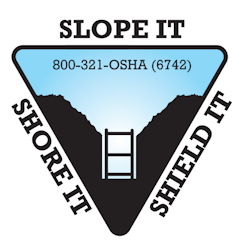Applying OSHA Standard
The Standards
29 CFR 1926.650, 29 CFR 1926.651, and 29 CFR 1926.652 are applicable OSHA standards.

The standard also provides several appendices:
- Appendix A, Soil Classification;
- Appendix B, Sloping and Benching;
- Appendix C, Timber Shoring for Trenches;
- Appendix D, Aluminum Hydraulic Shoring for Trenches;
- Appendix E, Alternatives to Timber Shoring; and
- Appendix F, Selection of Protective Systems;
The Basic Strategies
OSHA has made reducing trenching and excavation hazards the Agency's Priority Goal. Trench collapses, or cave-ins, pose the greatest risk to workers' lives. To prevent cave-ins:
- SLOPE or bench trench walls by cutting back the trench wall at an angle inclined away from the excavation;
- SHORE trench walls by installing aluminum hydraulic or other types of supports to prevent soil movement; or
- SHIELD trench walls by using trench boxes or other types of supports to prevent soil cave-ins.
Employers should also ensure there is a safe way to enter and exit the trench. Keep materials away from the edge of the trench. Look for standing water or atmospheric hazards. Never enter a trench unless it has been properly inspected.
Knowledge Check Choose the best answer for the question.
1-2. Cutting back the trench wall at an angle inclined away from the excavation is called _____.
You forgot to answer the question!
